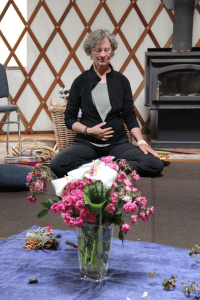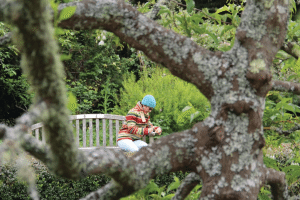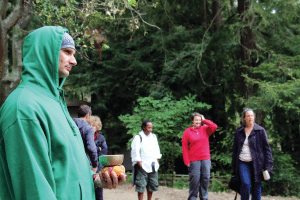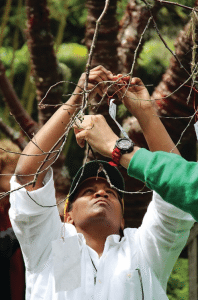Story and photos by Molly Oleson
When it comes time for Aaron Tozier to share with the group how nature has helped him heal, he admits that he doesn’t get out much. “I tend to isolate myself a lot,” says the 6’4’’ 39-year-old U.S. Army infantry veteran who served from 2003 to 2009, including time in Iraq from 2005 to 2006. “I tend to sit around and feel sorry for myself.”
Today, a foggy morning in April, is not one of those days. He sits with other veterans and supporters of vets in a circle formation in a yurt nestled in a grove of tall eucalyptus trees at the Green Gulch Farm Zen Center near Muir Beach. A wood-burning stove provides warmth. The chirping and wood-pecking of birds fills the silence between words.
They’ve come for a one-day retreat for veterans who have served since 1990—offered by Honoring the Path of the Warrior (HPW), a nonprofit organization sponsored by the San Francisco Zen Center.
The theme of the day is “the healing power of nature,” and one by one, the participants share their stories.
One veteran remembers the bamboo plant that helped her through her long deployment. “I knew that as long as it was alive, I could be alive,” she says.
Another veteran talks of spending hours below the deck of a ship during her six years in the Navy, and describes the calmness she felt when she came above deck. “Man, if the ocean can be still, why can’t I?”, she would ask herself.
Honoring the Path of the Warrior was founded in 2008 by Lee Klinger Lesser, who has been leading workshops in sensory awareness for more than 30 years, and Chris Fortin, a spiritual counselor and psychotherapist. Both women facilitate the retreats, drawing on their experiences with people of different ages and backgrounds. Right before the U.S. went into Iraq, both protested the war.
“Here we were going into Iraq—and now these were people who were the age of my children,” Lesser says. “And I started thinking about—what would happen to my children if they were sent into war, and what would I wish for them when they were coming home? And I realized that I would wish for my kids some very safe, very safe, secure place where people knew how to hold a space to meet suffering. Because I couldn’t imagine you could live through a situation in war and not meet suffering.”
Lesser says that there were many things about the war that she could not change. But she knew that she had something to offer: Sensory awareness, a mindfulness practice that had been a refuge for her from a young age.
“It’s a practice where you can literally come to your senses,” she says. “You can come into your own body, instead of feeling like this is something you ignore.”
We hold trauma in our bodies, she says, and the tightness and the experiences of our bodies have a lot to teach us. Through sensory awareness, we can find a sense of connectedness, calmness and a sense of ease to know that things can change.
“You get located in the present moment when you’re connected to your breath, to your sensations,” she says. “And that’s really helpful when your mind is spinning out and you’re caught in memory. And so you can just keep coming back to being right here, and feeling what’s needed and how you respond.”
Whether the tools would be of interest to veterans, Lesser says that she had no idea. “But I trusted that if they were of interest, they would be helpful.”
Only one vet showed up to the first event that Lesser and Fortin offered. Over time, more and more found them, and helped them know how sharing the mindfulness practices could be accessible and meaningful to veterans. The words honor and warrior came up over and over again. Deep wounds—memories carried alone—were shared in intimate spaces.
“I’m learning all the time,” Fortin says of leading HPW. “My sense is that it is an active process, because returning vets are in an active process of trying to find meaning and grounding in what they carry for all of us.”
Mindfulness, it has been proven, has been effective in reducing stress, anxiety, depression, isolation and other difficult emotions that veterans struggle with.
A veteran who was involved in the beginning told Lesser, “You never feel more alive than when you’re at war.” The statement, Lesser says, was stunning, sad and uncomfortable. But she says that she also understood it. “Because there’s a kind of intensity and vitality and awakeness, because everything depends on it,” she says. “And actually, that’s kind of the essence of practice that you should be alert because this moment matters.”
Lesser, who once lived at Tassajara Zen Buddhist Monastery and now describes the intensity of need for sensory awareness among vets, recalls formal chants that were practiced right before days off: You should practice as though your head is on fire. You should practice as though you were a fish in a puddle of water.
“I feel like so many veterans are coming back, and their heads are on fire,” she says. “And they’re looking so much for some kind of comfort and refuge and source of healing. So there’s that kind of ripeness for soaking in practice.”
A Place of Healing
Fortin, along with her husband Bruce Fortin, a psychotherapist and mediator in private practice, take turns

leading the day’s mindfulness exercises with calmness and grace. Green Gulch is a special place for them—it’s where they got married, and where their son was born.
Honoring the Path of the Warrior, Chris says, aims to create a safe space in which to be held and witnessed. There’s never a push to make people feel something. “There’s just a place to let yourself feel what’s there to be felt,” she says. “Gently. Over time.”
The Fortins alternate taking the lead, introducing vets to Qigong—an ancient Chinese practice that integrates postures, breathing techniques and focused intention—walking meditation and breathing exercises. “Practice letting thoughts go,” Bruce instructs, as the veterans close their eyes.
He tells them that they can use visualization and breathing to call in energy and let it sweep through their bodies. “Let that healing energy come in, and let your heart receive it.”
“Moments of grace” can happen when the mind begins to quiet, he says. It’s painful to study ourselves sometimes, he acknowledges. “Be open to how the universe comes forward to support you.”
The group stands up to do a meditation exercise that involves walking around the room. “Every time your foot touches the ground,” Bruce says, “see if you can feel the energy—you’re giving energy and you’re receiving energy. As soon as you aren’t aware of your feet, it usually means the mind has kicked in.”
Most times, he says, we can’t receive energy because we’re in the past, or the future, or we’re worrying about something.
“The world has all the magic you need right here in this moment,” he tells them. “All you have to do is be open to it.”
An exercise stirs up difficult memories for one of the vets, and she shares her feelings, head down, with the group.
“That last visualization was painful,” she says. “It brought a memory up—some grief I’m trying to avoid right now.” Bringing her knees up to hug, she begins to cry. Chris scoots over from her round cushion on the floor and places a supportive hand on the woman’s orange-and gray-striped sock. “But that’s probably why I’m here.”
Military Culture
“You have to have a specific mentality to sustain that lifestyle,” Jasmine says of being in the military. The 28-year-old Daly City native spent four years as a mechanical engineer aboard the USS Nimitz, the Navy’s oldest aircraft carrier. It was dangerous, she says, but she didn’t have time to think about that. “It’s very difficult to explain to people who haven’t been immersed in it.”
Jasmine, who recently moved to the Bay Area from Southern California, attended the Green Gulch retreat on the recommendation of Veterans Affairs in San Francisco. She had heard about meditation before, but she hadn’t practiced it. “I joined out of curiosity,” she says. What she found was an opportunity to slow down.
“There’s a mentality in the military where you have to carry things with you,” she says. “And keep on going. It fosters the idea of not taking time for yourself. Keep pushing towards the mission, keep pushing towards the goal.”
The retreat taught her that it’s important—and OK—to breathe. Since Green Gulch, Jasmine has participated in another HPW retreat—a five-day stay for women vets at Tassajara. “It was a huge turning point in my life,” she says of the rejuvenating experience.
“Some things I didn’t even know were there, were shared,” she says. “If the space is open, it opens your mind up to things you’ve filed away.”
Dyan Ferguson, a South African immigrant who joined the National Guard right out of high school in 1985 and who now works for HPW, shares some of Jasmine’s sentiments about the military.
“The day I left the military, I wanted nothing to do with it ever again,” Ferguson says, noting that while in it, she lived with her bags packed by the door, and a sense that her name was high on the list to go to the Persian Gulf or Bosnia. “You just live with this pressure,” she says. “They want you to think—they sort of teach you to think—that everything you do could have some life or death consequence.”

It’s hard to let that go when you leave the military, she says, when you don’t need to carry it anymore. Some people don’t want to let it go—they miss it when they leave, she says.
But for Ferguson, one of the most amazing things about the military was the strong sense of belonging that she felt.
Although she says it took years to “unravel” the internal conflicts that she had about her time there, she was grateful for the sense of community, and for the commitment to service—something that has deeply inspired Chris and Lesser.
It’s a bond over a shared experience that HPW vets understand. The ongoing mindfulness practice builds a strong sense of community. And it’s a community, Lesser says, in which many veterans are proud of their service, and grateful for it.
“There’s a sense of continuity and refuge that people can really depend on,” Chris says.
And mindfulness has a cumulative effect, Ferguson says. “The more you practice, the more effective it becomes.”
Bridging the Gap
Chris tells the vets at the beginning of the day how HPW started from the idea of trying to find some way to smooth the transition from military to civilian life.
“We both knew how much our practices had helped us transform and ground our own hearts and minds and bodies,” she tells them, of she and Lesser wanting to share with veterans.
Chris tells them that her father was a veteran of World War II, who was awarded the Bronze Star. He never talked about his time in the war, she says, but she could feel it. “I knew he was carrying something,” she says. And then she thanks them. “You’ve all helped me understand my own life and know him better.”
People can sit isolated in their lives, Lesser says, and not be touched by what veterans are left to carry. There’s a gaping space between military and civilian life, where stereotypes and assumptions live. People will sometimes approach veterans and ask them what the worst thing they saw was, and if they had killed anybody.
“I mean, just such a disconnect from what we’ve asked of human beings,” Lesser says. “And we’ve sent folks over there, and then we’re leaving them as though it’s their problem when they come back. And to me, that’s pretty disgraceful.”
Lesser hopes to share an understanding, appreciation and respect for what veterans are living. “We should all be carrying what they’re left with,” she says.
Every Moment is a Moment
Tozier says that joining the military was probably the best decision that he’s ever made in his life. It taught him discipline, structure, integrity—all of the things he says that he was lacking at the time.
“I went there with my eyes wide open,” he says of Iraq. “I knew what I was getting into. But it has affected me. It has affected me a lot.”
When he returned from combat in 2009, Tozier coped with coming back by drinking. When he realized that alcohol wasn’t working to ease his pain, he checked himself into a 90-day program with Veterans Affairs for PTSD and alcohol abuse.

“Today, I choose to deal with life with healthier activities,” he says, noting that he joined HPW on a river rafting trip three years ago, and has since been a part of at least 10 of the veteran retreats. His first experience with meditation, the rafting trip opened him up to something that he was once skeptical of.
“I am the last person I would ever expect to say, ‘I do meditation,’” Tozier, a self-described adrenaline junkie, says. “I’m just a macho kind of guy. Infantry. You don’t talk about your feelings; you don’t show emotion.”
The first time that Tozier saw people express sadness in the military, he says, was when his good friend, 26 years old and a father, was killed in combat. “That shook everybody up,” he says. But he doesn’t remember anybody talking about it. “It was more … I could see people crying. Just emotion.”
He remembers that there were civilian people there for them, if they wanted to talk. He didn’t. “I just wanted to be left alone,” he says.
About a month ago, Tozier got together with some fellow veterans for a 10-year anniversary. He saw his late friend’s widow and the daughter who lost her father. “It hadn’t really hit me that he’s gone,” he says, choking back tears, “until I saw his beautiful little girl.”
“It’s OK,” he says, his voice cracking, of expressing sadness. “It’s good for me.”
Tozier has learned, over time and with practice, to let himself feel things; to be mindful of the present.
“I have a tendency to get stuck in the past or to worry about the future,” he says. “Sometimes being in the present sucks. I’m full of anxiety, fear … my mind is going crazy.”
Honoring the Path of the Warrior, Tozier says, has taught him to concentrate on his breath to find freedom in the moment. “They’ve taught me that everything is OK in this moment,” he says of Lee and Chris, emphasizing the huge impact they’ve had on his life. “You can’t change the past. You can work on the past and try to deal with the experiences that affected your life in a negative way.”
When anxiety creeps in, he says that he reminds himself that “every moment is a moment.”
Tozier, who was awarded the Purple Heart from wounds received during combat, says that just being there at Green Gulch resonated the most for him. “It’s kind of like a different world down there,” he says. “It’s peaceful; it’s safe.”
He talks about lying down in the grass and looking up at the trees. “There’s no other place that I feel comfortable lying down like that, except in my room.”
The Paradigm
“I always tell people, ‘You’re never going to be the same.’” Lesser says that a chaplain who had been in the military for decades and deployed to many combat zones, once came to an event and said that.
“And that was really important when he said that,” she says. “You are never going to take these experiences out of you and be the same as you were before. But to find how you live with them and how you use what you have lived through to create more peace and connection in our world and more healing for other veterans—that’s very meaningful.”
Tozier participated in an HPW training to become a veteran leader at retreats because he felt like he had a lot to offer other vets, especially those coming in with skepticism of meditation and mindfulness, as he had. “If they’re open-minded enough, then it can help them as much as it’s helped me.”
Honoring the Path of the Warrior has plans to expand to other communities that have a desire to help veterans. Lesser and Chris hope to provide tools that veterans can use for the rest of their lives, and that they have a place to rest, to feel welcomed and seen as whole. “Our paradigm has always been to meet each person where they are, with acceptance. Unconditional acceptance, and regard and love,” Chris says.
Dyan says that if she hadn’t come across HPW, she might never have been around veterans ever again. “You know, because I rejected that so strongly when I left, it’s been great to be able to come back to it, and experience the good in it—which is that camaraderie and that fellowship and that loyalty and integrity of my fellow veterans,” she says. “That’s been really fun to just kind of reclaim that part of the experience–leave the rest behind.”
Leaving it Behind
In one of the last exercises, the vets walk to the gardens and stop frequently along the path to observe and to breathe. Before leaving the yurt, Chris says, “See what opening yourself up to nature teaches you about yourself.”
To a tree, they tie handwritten messages that read, Let go of expectations, level, judgment.
Walk toward fear, beside or behind, not blocking the way.

Happiness is a choice.
Light. Kindness. Loving. Laughing. Living.
As the pieces of paper flap in the wind, the vets head back to the yurt. They place flower petals, tree branches and other offerings from nature on a blanket in the middle of the room.
The last exercise of the day is about reflecting on what they’ve learned. They split off into groups of two and three.
“I’ve never been a war person,” one vet admits to her partner in a soft voice—almost a whisper. “And I’ve got a lot of war years in me.”
She wears a necklace with a round pendant on which ‘Pace’—Italian for ‘Peace’—is engraved. She describes bouts of substance abuse and homelessness, where she chose to live in her truck because she liked the safety and the freedom that came with it.
“It’s hard,” she says. “I almost didn’t make it here today out of shame.”
She’s glad she did. Meditation, she says, is the one thing that keeps her sane. There’s a relief that comes with shedding the “cloak of anxiety.”
The woman she is paired with—who is not a veteran herself, but who was deeply affected by war when she was in the Peace Corps—looks her straight in the eyes. “You’re glowing,” she tells her.
“Thank you—I’m trying,” the vet says, nodding. Her smile is bigger than it’s been all day. “This feels like coming home.”
Meet staff and veterans from Honoring the Path of the Warrior at the French Garden restaurant in Sebastopol on August 2 from 1-2:30pm, or contact dy**@*************th.org about upcoming one-day events on Saturday, August 15 at Green Gulch Farm. Learn more at honoringthepath.org.








